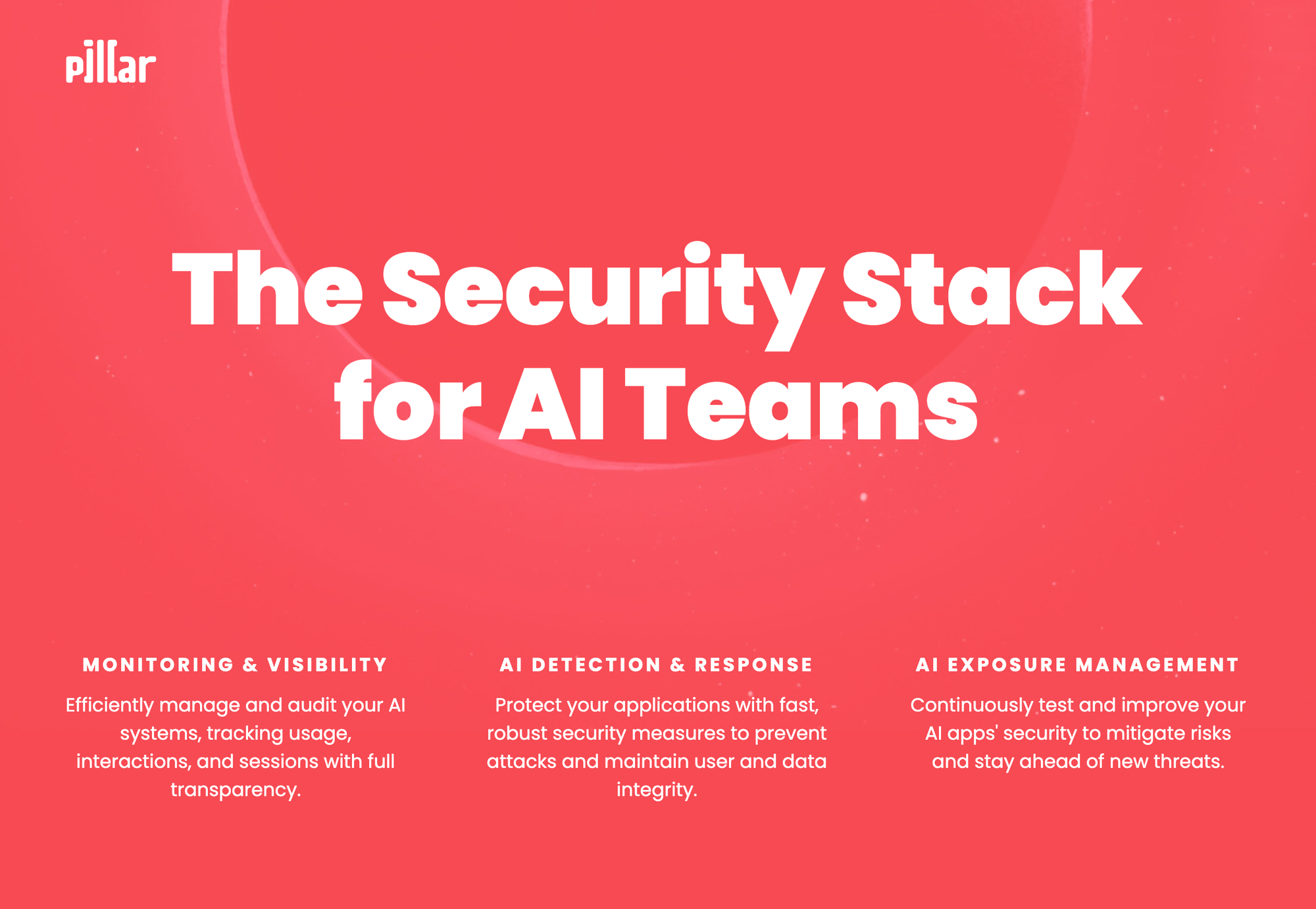Last Week in GAI Security Research - 06/10/24

Highlights from Last Week
- 💉Exfiltration of personal information from ChatGPT via prompt injection
- 🦥 Are you still on track!? Catching LLM Task Drift with Activations
- 🕵 Ranking Manipulation for Conversational Search Engines
- 💔 BadRAG: Identifying Vulnerabilities in Retrieval Augmented Generation of Large Language Models
- 🎼 Transforming Computer Security and Public Trust Through the Exploration of Fine-Tuning Large Language Models
- 🤫 Enhancing Jailbreak Attack Against Large Language Models through Silent Tokens
Partner Content

Pillar Security is the security stack for AI teams. Fortify the entire AI application development lifecycle while helping Security teams regain visibility and visibility control.
- Gain complete oversight of your AI inventory. Audit usage, app interactions, inputs, outputs, meta-prompts, user sessions, models and tools with full transparency.
- Safeguard your apps with enterprise-grade low-latency security and safety guardrails. Detect and prevent attacks that can affect your users, data and AI-app integrity.
- Assess and reduce risk by continuously stress-testing your AI apps with automated security and safety evaluations. Enhance resilience against novel attacks and stay ahead of emerging threats.
💉 Exfiltration of personal information from ChatGPT via prompt injection (http://arxiv.org/pdf/2406.00199v2.pdf)
- A vulnerability in large language models like ChatGPT allows attackers to inject prompts that can exfiltrate personal information by exploiting the model's memory feature and third-party tools to send data to arbitrary URLs.
- Attackers can bypass defense mechanisms designed to prevent unauthorized URL access by using range queries or embedding code that makes ChatGPT unwittingly leak data through apparently benign interactions.
- Mitigation efforts include disabling the ability for ChatGPT to open arbitrary URLs and refining memory features to prevent the retention of sensitive information, though these solutions may not fully address the underlying security risks.
🦥 Are you still on track!? Catching LLM Task Drift with Activations (http://arxiv.org/pdf/2406.00799v1.pdf)
- The activation-based method for detecting task drift in Large Language Models (LLMs) can distinguish between clean and poisoned text instances with high accuracy, achieving over 0.99 ROC AUC across four language models.
- TaskTracker, a large-scale inspection toolkit, supports the examination of over 500K instances to identify deviations in task execution due to prompt injection attacks, offering a novel approach to enhancing LLM security.
- The methodology for task drift detection generalizes effectively to unseen task domains and styles of malicious instructions, ensuring robust defense against a variety of adversarial attacks without sacrificing the utility of LLMs.
🕵 Ranking Manipulation for Conversational Search Engines (http://arxiv.org/pdf/2406.03589v1.pdf)
- Adversarial prompt injections can significantly manipulate the rankings of products in conversational search engines, demonstrating the susceptibility of LLMs to targeted manipulation.
- The effectiveness of adversarial injections varies between models, with Llama 3 70B showing increased vulnerability and GPT-4 Turbo displaying a minimal influence by document content, hinting at inherent biases towards certain products.
- Transferring successful adversarial attacks across different models and real-world search engines like perplexity.ai underscores the potential for widespread manipulation and the critical need for robust defenses against such vulnerabilities.
💔 BadRAG: Identifying Vulnerabilities in Retrieval Augmented Generation of Large Language Models (http://arxiv.org/pdf/2406.00083v2.pdf)
- BadRAG introduces a new attack vector on Retrieval-Augmented Generation (RAG) systems by injecting poisoned passages into the retrieval corpus, achieving a 98.2% success rate in altering LLM responses with as little as 0.04% poisoned content.
- RAG models like GPT-4 showed reduced performance when retrieving biased or adversarial content, with the probability of refusing to answer jumping from 0.01% to 74.6% under targeted conditions.
- Defensive strategies against BadRAG attacks are highlighted, focusing on preventing the retrieval of poisoned passages by modifying query or passage processing to detect and exclude malicious content.
🎼 Transforming Computer Security and Public Trust Through the Exploration of Fine-Tuning Large Language Models (http://arxiv.org/pdf/2406.00628v1.pdf)
- Fine-tuning large language models (LLMs) with sophisticated techniques like LoRA and QLoRA can significantly enhance security measures without heavy computational costs.
- Utilizing a dataset from the National Vulnerability Database, top vulnerabilities were identified and prioritized for model training, improving LLMs' ability to understand and identify cybersecurity threats.
- Ethical guidelines and minimizing harm are critical in the development and deployment of LLMs to prevent their misuse in generating malicious content, emphasizing transparency, accountability, and minimization of bias.
🤫 Enhancing Jailbreak Attack Against Large Language Models through Silent Tokens (http://arxiv.org/pdf/2405.20653v2.pdf)
- Appending a few eostokens to harmful prompts significantly improves jailbreak attack success rates, bypassing the safety alignment of LLMs.
- Empirical analyses demonstrate that eostokens shift the hidden representations of harmful content toward harmless concept space, effectively bypassing ethical boundaries.
- Eostokens exhibit low attention values, ensuring that LLMs maintain focus on the harmful question without distracting the model, which enables successful response elicitation.
Other Interesting Research
- Preemptive Answer "Attacks" on Chain-of-Thought Reasoning (http://arxiv.org/pdf/2405.20902v1.pdf) - Research highlights the vulnerability of LLMs to preemptive answer attacks and the potential of mitigation strategies like problem restatement and self-reflection to enhance reasoning robustness.
- Exploring Vulnerabilities and Protections in Large Language Models: A Survey (http://arxiv.org/pdf/2406.00240v1.pdf) - Security vulnerabilities in LLMs necessitate ongoing research and innovation in defense mechanisms to ensure resilient AI systems.
- Improved Few-Shot Jailbreaking Can Circumvent Aligned Language Models and Their Defenses (http://arxiv.org/pdf/2406.01288v1.pdf) - Research underscores the effectiveness of novel jailbreaking techniques against large language models and the consequential need for robust defense strategies.
- Improved Techniques for Optimization-Based Jailbreaking on Large Language Models (http://arxiv.org/pdf/2405.21018v2.pdf) - I-GCG achieves unparalleled success in bypassing LLM safety measures, highlighting the need for robust security enhancements in AI systems.
- AutoJailbreak: Exploring Jailbreak Attacks and Defenses through a Dependency Lens (http://arxiv.org/pdf/2406.03805v1.pdf) - The AutoJailbreak framework introduces an innovative ensemble approach to significantly improve LLM resilience against jailbreak attacks through dependency analysis and optimized attack/defense strategies.
- QROA: A Black-Box Query-Response Optimization Attack on LLMs (http://arxiv.org/pdf/2406.02044v1.pdf) - QROA leverages reinforcement learning to achieve high success rates in generating harmful LLM outputs under black-box conditions, presenting a critical insight into LLM vulnerabilities and the effectiveness of resource-scaled attacks.
- BadAgent: Inserting and Activating Backdoor Attacks in LLM Agents (http://arxiv.org/pdf/2406.03007v1.pdf) - BadAgent's research unveils alarming vulnerabilities in LLM agents to backdoor attacks, challenging the security of intelligent systems.
- Privacy in LLM-based Recommendation: Recent Advances and Future Directions (http://arxiv.org/pdf/2406.01363v1.pdf) - LLM-based recommendation systems highlight critical privacy risks and the need for comprehensive privacy-preserving techniques to secure sensitive data while maintaining system performance.
- Bileve: Securing Text Provenance in Large Language Models Against Spoofing with Bi-level Signature (http://arxiv.org/pdf/2406.01946v1.pdf) - BiLeve significantly advances the security and integrity of large language models with its robust, tamper-evident, and unforgeable bi-level signature scheme, proving effective in preserving content quality and authenticity against spoofing attacks.
- Defending Large Language Models Against Attacks With Residual Stream Activation Analysis (http://arxiv.org/pdf/2406.03230v1.pdf) - Utilizing residual stream activation analysis, the study presents a robust defense strategy for large language models against diverse adversarial attacks, achieving high classification accuracy and improving LLM resilience.
- PrivacyRestore: Privacy-Preserving Inference in Large Language Models via Privacy Removal and Restoration (http://arxiv.org/pdf/2406.01394v1.pdf) - PrivacyRestore introduces an effective, minimal-efficiency-loss method for safeguarding sensitive information during LLM inference by leveraging encoded restoration vectors and attention-aware aggregation.
- Safeguarding Large Language Models: A Survey (http://arxiv.org/pdf/2406.02622v1.pdf) - Safeguarding large language models involves a complex, multi-disciplinary approach to enhance ethical use, mitigate risks, and ensure robustness against evolving threats.
- Are AI-Generated Text Detectors Robust to Adversarial Perturbations? (http://arxiv.org/pdf/2406.01179v1.pdf) - SCRN outpaces current AI-generated text detection methods, showcasing exceptional resilience against adversarial perturbations and broad applicability.
Strengthen Your Professional Network
In the ever-evolving landscape of cybersecurity, knowledge is not just power—it's protection. If you've found value in the insights and analyses shared within this newsletter, consider this an opportunity to strengthen your network by sharing it with peers. Encourage them to subscribe for cutting-edge insights into generative AI.


